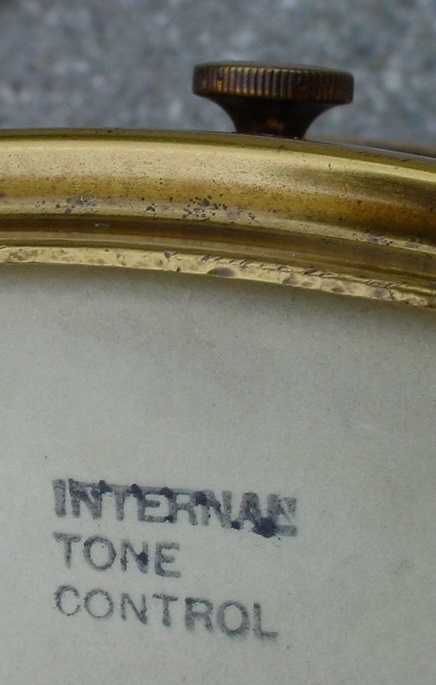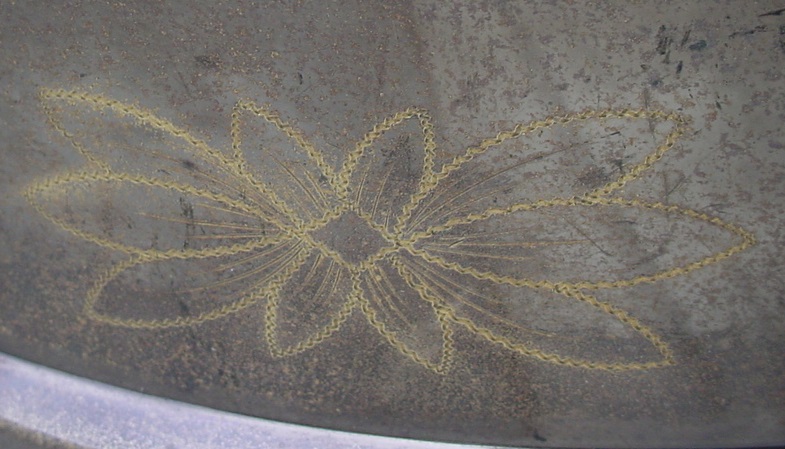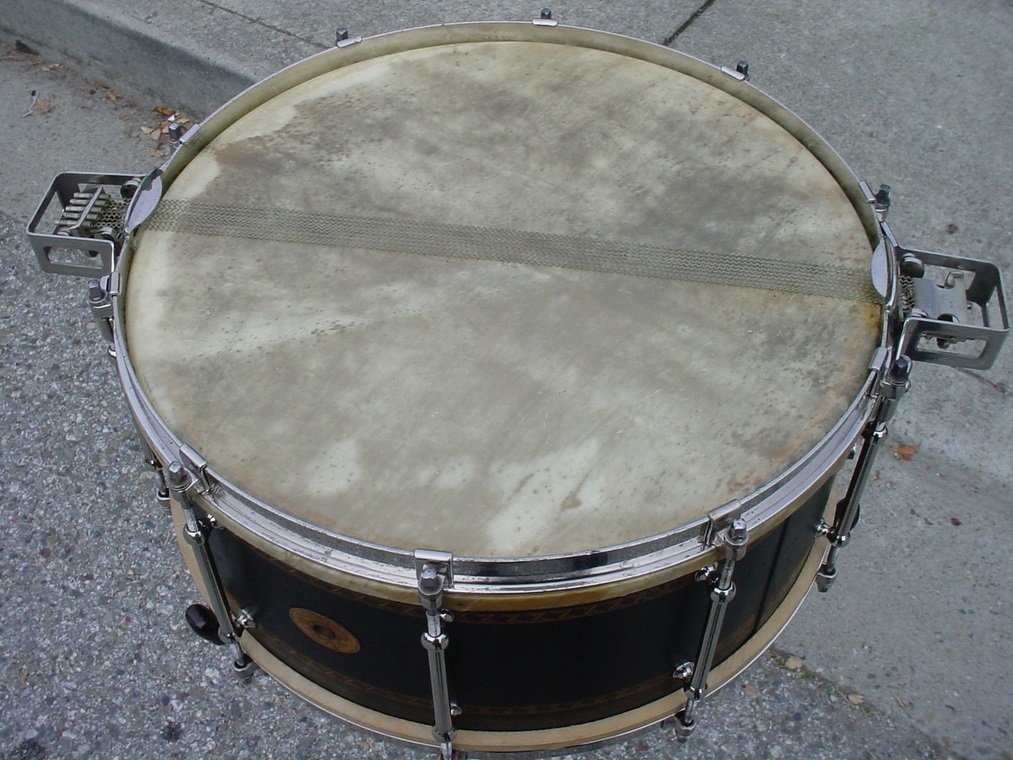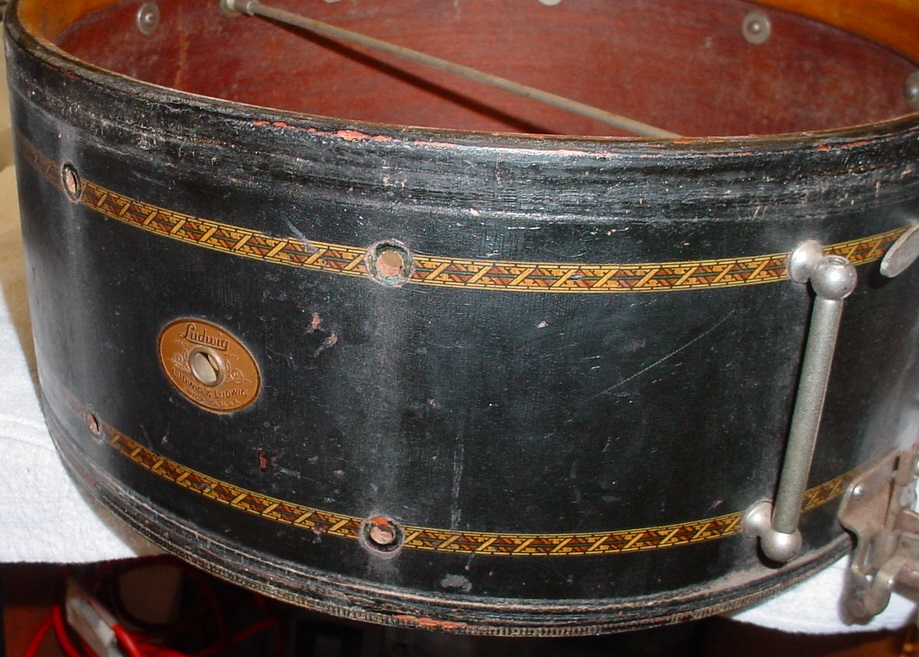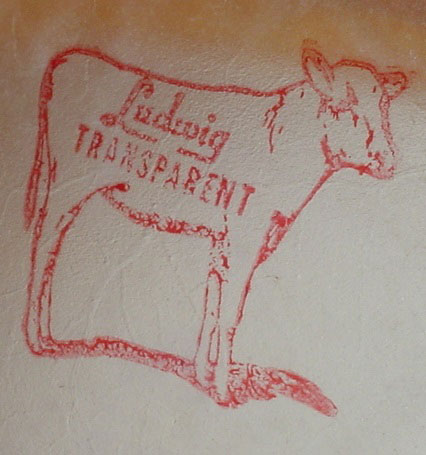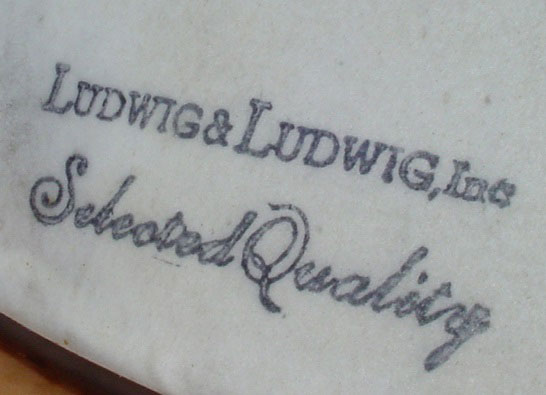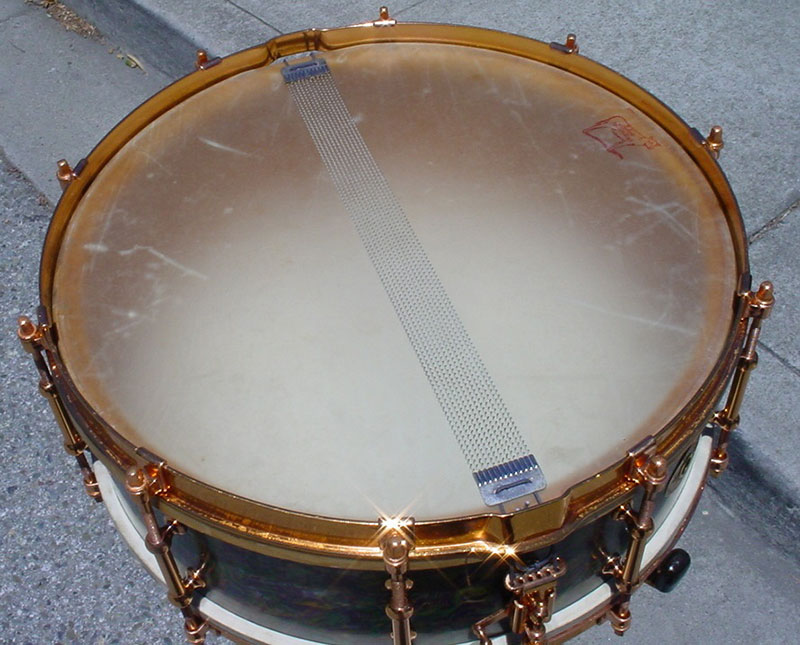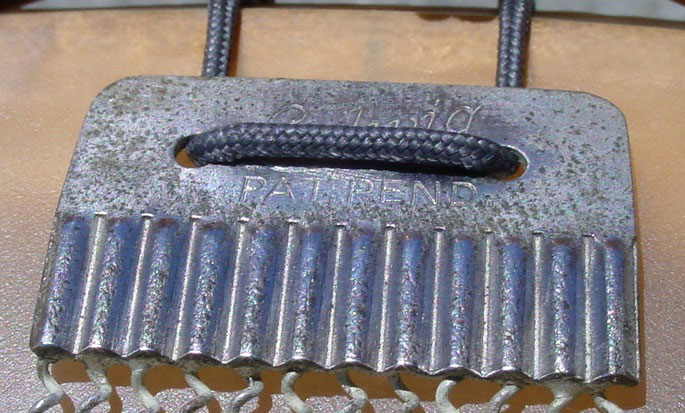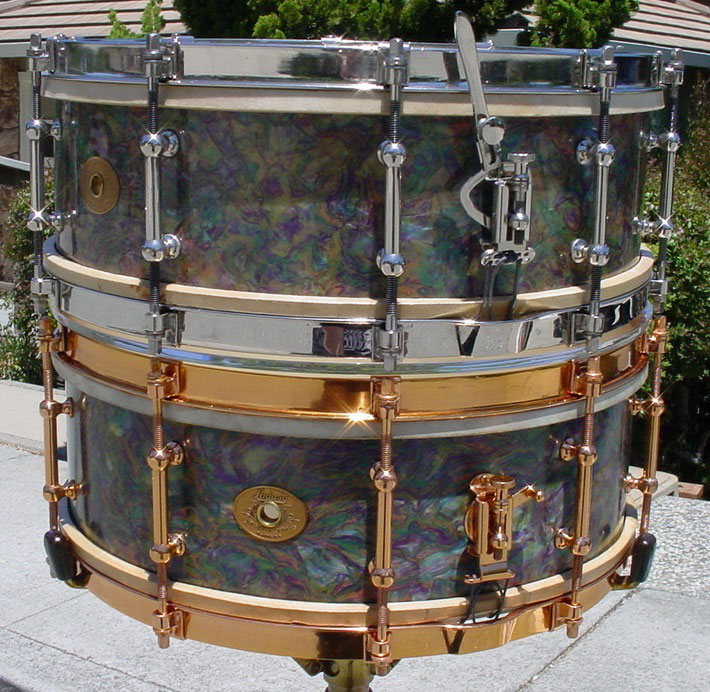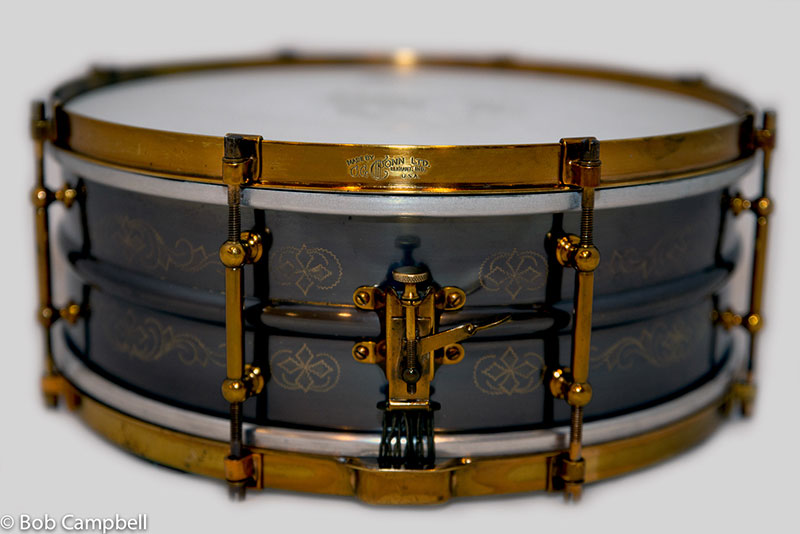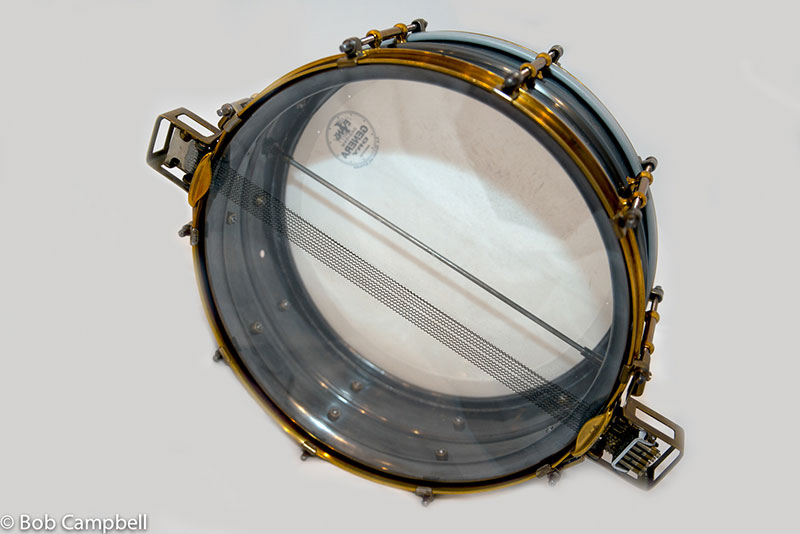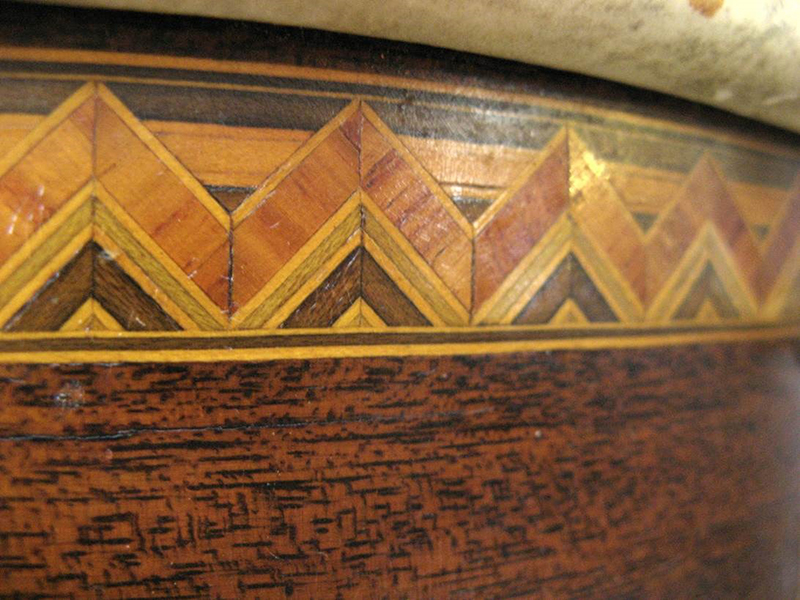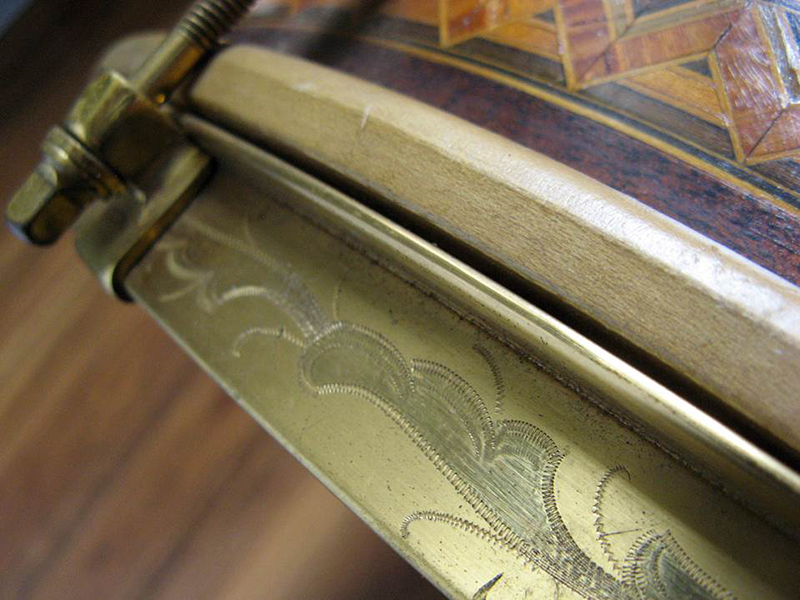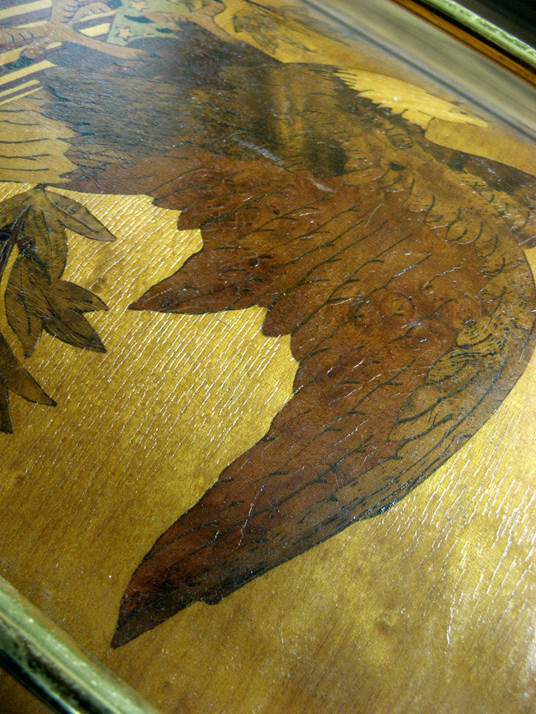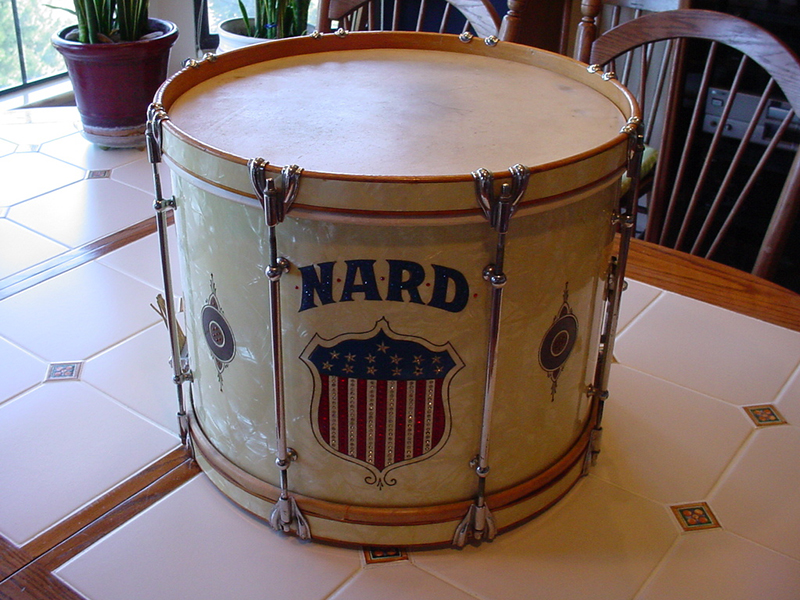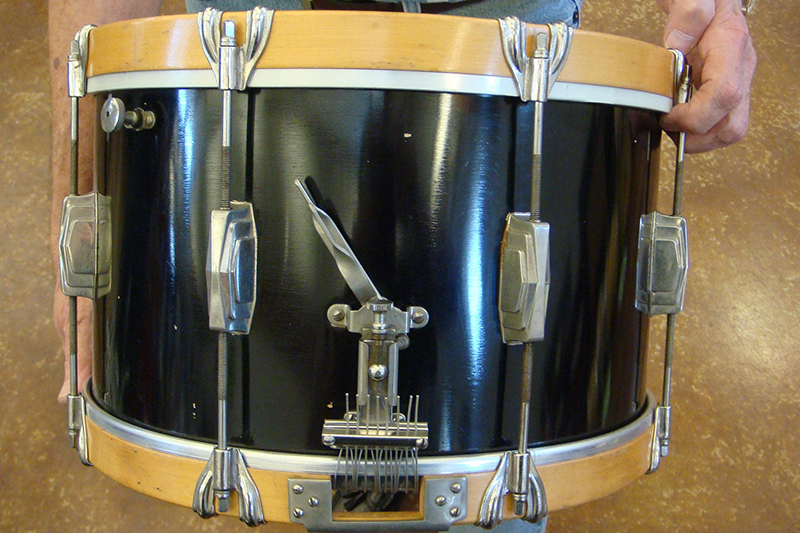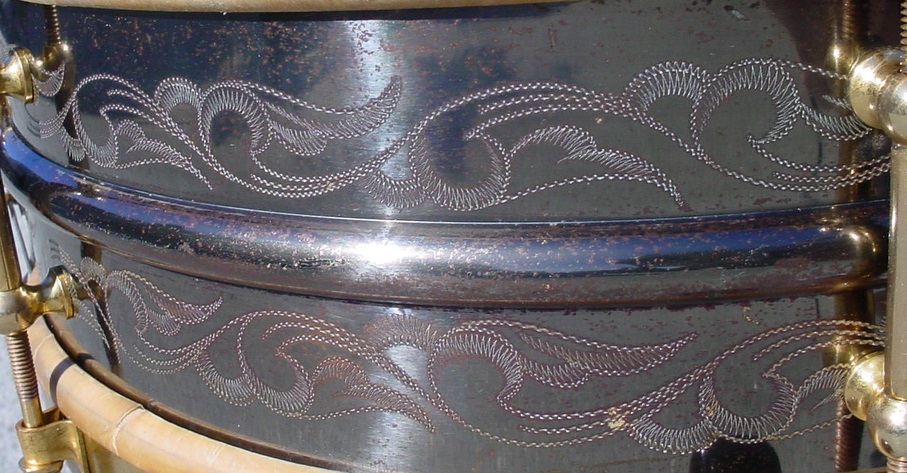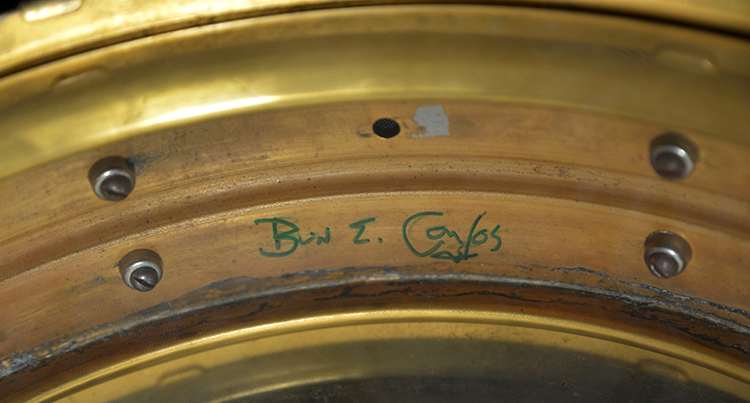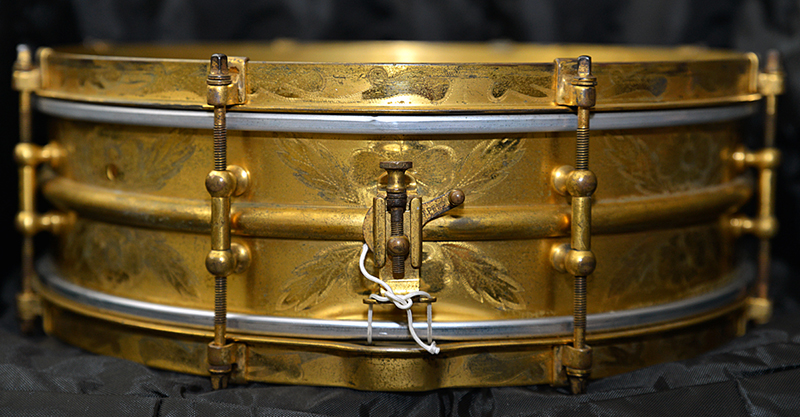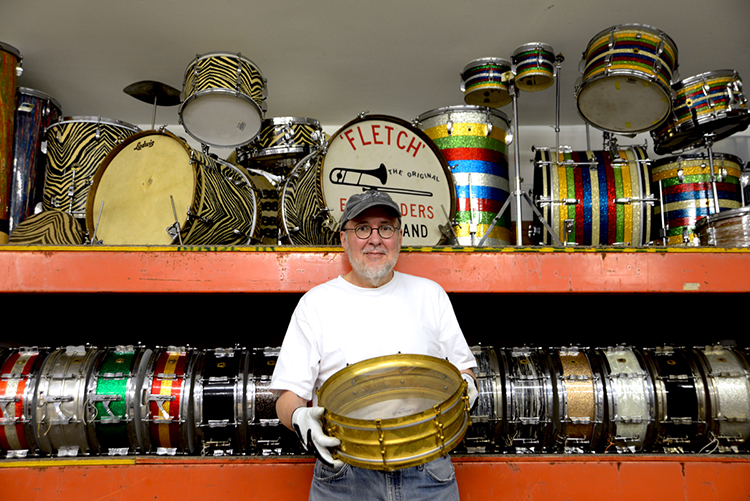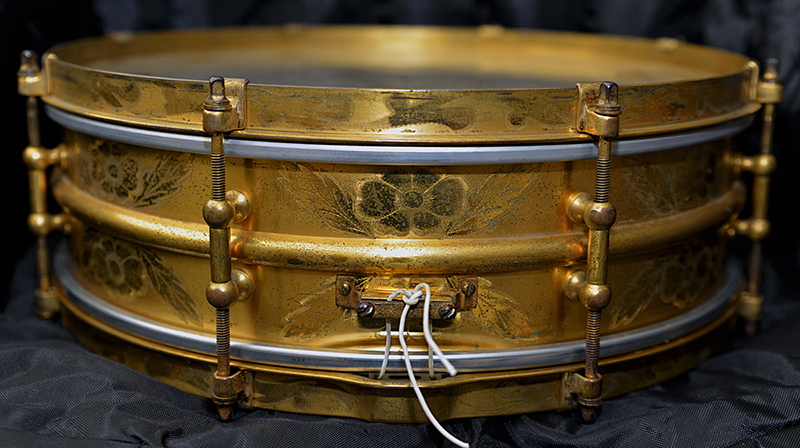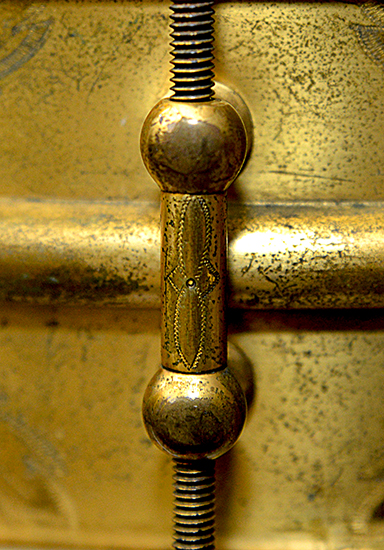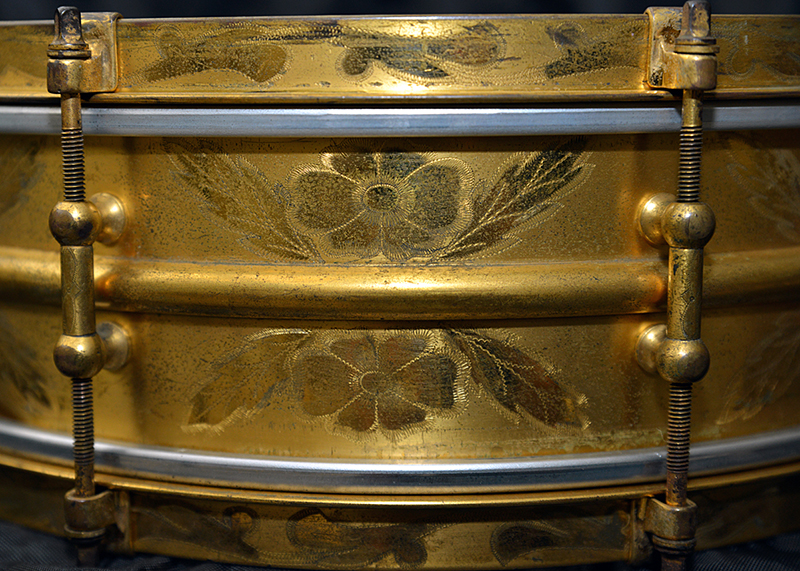Here’s another snare drum fresh from the 2015 Chicago Vintage Drum Show and now in the “Bun E. Carlos wing” of the Curotto Collection. I got this one from Bun E. Carlos.
Read more1935-36 Ludwig & Ludwig Silver Anniversary Black Beauty
By Mike Curotto
1935-36 LUDWIG & LUDWIG 6.5 x 14 SILVER ANNIVERSARY BLACK BEAUTY
Hi all,
Here’s another snare that I was able to add to the collection...fresh from the 2015 Chicago Vintage Drum Show. I got this drum from Joe Luoma, he had one to spare so we sealed the deal over the phone 3 weeks prior to the Show and culminated the deal at the Show. Thanks goes to Joe for helping me to add another cool and very rare drum to my collection. Joe’s drums are always pristine so this was an easy cleaning.
The SHELL:
The “sparse” later 1930s 10 pt. floral engraving pattern is clean and in good shape. The black nickel is also in good condition with some normal “freckling” that is to be expected on an 80 year old drum. I just gave the shell a minor cleaning with some lemon oil and all is good.
The HARDWARE:
Around 1932 Ludwig changed their Artgold (bright copper plating /gold lacquer) DeLuxe hardware option to Classic Gold (brass plating/ yellow gold lacquer). The Classic Gold on this snare drum was in very good condition and only needed a basic cleaning. The threads on the tension rods needed the most cleaning. One side of one of the tapped Imperial lugs was stripped but my good friend Al Schneider, The Drum Doctor, did his magic with a 12-24 Heli-Coil and as I’ve mentioned before, do not let stripped “Anniversary” lugs be a deal killer, there is a fix, a 12-24 Heli-Coil is the correct fix.
Of-the-era calf heads (note the tone control stamp on the top head) and James Snappi wires rounded out this simple cleaning.
Silver Anniversary Black Beauties are extremely rare, there are only 5 known at this writing and every one is different but I do realize that there is always the possibility that there are others out there. Be sure to weigh-in if you see or hear of another Silver Anniversary Black Beauty out there in vintage drum land.
Here’s a list of the 5 known Silver Anniversary Models:
- 5 x 14 gold plated Standard Model (Joe Luoma Collection)
- 5 x 14 gold plated Super-Ludwig Model (Joe Luoma Collection)
- 6.5 x 14 chrome plated Standard Model (Bun E. Carlos Collection)
- 4. 5 x 14 chrome plated Super-Sensitive Model (Mike Curotto Collection)
- 6.5 x 14 Classic Gold Standard Model (Mike Curotto Collection)
Enjoy!
1929 5x14 Ludwig & Ludwig Rose Pearl Standard-Sensitive Model
I love the Rose Pearl description by L&L: "Rose 'Pearl' is a red hot finish for red hot drummers. It has the zipp (sic), and the Pep, and is just what the collegiate chap has been looking for. Rose 'Pearl' looks best with DeLuxe rods....Prepare for that better job by getting a set of new Ludwig 'Pearl' drums.
Read more1925-32 Ludwig & Ludwig 6.5x15 Black Ebonized Inlay Super-Ludwig Band Model
By Mike Curotto
Hi all,
This snare drum was a gift to me from my good friend and fellow drum collector Bun E. Carlos. We had done a couple of big deals at the 2012 and 2013 Chicago Vintage Drum Shows so as a thank you Bun gifted me this drum.
1925-32 LUDWIG & LUDWIG 6.5 x 15 BLACK EBONIZED/INLAY SUPER-LUDWIG BAND MODEL
The Shell:
The Black Ebonized finish (1925-1939) was originally a special order but in later catalogs it was offered at no extra cost. The finish shows its age but is all there and cleaned up nicely with a product called Naphtha. I just learned about this product from a friend who does a lot of custom woodworking. I am happy with the outcome as this product did not harm the finish. The Black Ebonized finish is also high-lighted with two “decorative” faux inlay decals that surround the shell. The solid mahogany shell interior is in good shape and is factory-marked ”BLACK”. The brass oval badge is clean with a tight grommet. There is no tone control, definitely pre-1933.
The Hardware:
The nickel hardware is all original but it definitely needed a good cleaning and polishing. Everything came out great. The Super mechanism works perfectly. The bottom rim has the stamped “Super Ludwig” which puts it after the earlier engraved “Super-Ludwig” models. The original Super wires are intact and work well.
Of-the-era top and bottom calf heads rounded out this restoration. These 6.5 x 15 Super-Ludwig Band Models are classic examples of a great era. Thanks again goes to Bun E. Carlos for gifting me a great drum.
Enjoy!
The WWII Collection
"Here are a couple of pics of the World War II collection. The L&L is completely restored. The 1st version WFL (with the rolling bomber snare) werepurchased new, played for a year at home and put in the closet for 70+ years - they still have the original Calf heads on them. I am the 2nd owner. A BDP Rollin Bomber kit with a very rare 10" off set lug tom. I am the second owner as well. At the show I will also have a 1st version (Cecil Stupe design) WFL internal tune kit in WMP that I am restoring."
Read more1927-32 L&L DeLuxe Super Snare
Here’s another snare drum to enter the collection. I got this drum in May from a very nice gentleman named Mark Hamon. For those of you that are old Not So Modern Drummer subscribers you will recognize Mark as the photographer of all of those great NSMD cover shots. A thank you goes out to Bill Wanser for helping me to date this drum.
Read more1928-30 L&L "Rainbow" Pearl
Hi all,
I just got this 1928-30 5 x 14 Ludwig & Ludwig “Rainbow Pearl”/DeLuxe Standard Model snare drum from my good friend and fellow collector Donn Bennett of Donn Bennett Drum Studios in Belleview, WA. The drum needed no cleaning or restoring. The solid maple shell interior is clean with a tight grommet/badge and the “finish” is very clean. There is no tone control, tone controls show up in the L & L catalog around 1932 hence the 1928-30 dating. The DeLuxe hardware was restored by Adrian Kirchler of AK Drums in Italy. The only thing I added was of-the-era top and bottom Ludwig & Ludwig calf heads and Ludwig & Ludwig Snappi-type wires.
The real story is in the identification of the finish that is on this drum. I’ll try to explain as best as I can but there are definite inconsistencies that I will site along the way. The finish on this drum (and on the only other drum like this that I have ever seen) has been referred to as “Rainbow Pearl”. I have included a comparison photo of both drums. Ludwig & Ludwig never had a cataloged finish called Rainbow Pearl but they did have the Rainbow Outfit but the drums were finished in Lavender Pearl (1928-35). Leedy introduced Rainbow Pearl in 1930 and it has been suggested that the finish on this drum was taken from the “Leedy side” of the building as Leedy and Ludwig & Ludwig were literally built across the way from each other as they were both owned by the C. G. Conn Co. at that time but the Leedy Rainbow Pearl snare that I own does not look at all like the “Rainbow Pearl” drum in this article. I have also included a comparison photo of the Leedy drum and this drum so the reader can see what I am talking about.
Another theory is that this could be a variation of a “run” of 1928-30 Peacock Pearl. More photos are available on page 153 of The Ludwig Book by Rob Cook, this is a nice presentation of Peacock Pearl I and Peacock Pearl II. Please note that at the top of page 153 Rob lists Peacock Pearl version I (1928-30) and Peacock version II (1930-32) but reverses the the order in the photos; the top photos should be labeled Peacock Pearl II and the bottom photos should be labeled Peacock Pearl I and be aware that the drum in the lower left is the “other” Rainbow Pearl drum that I mentioned earlier. Having fun yet, are you still with me? So what are we going to call this finish...Rainbow Pearl, Peacock Pearl I, a variation of Peacock Pearl I, a one-off run of an un-cataloged finish, a one-off special order, frog in a blender, Walt Disney threw up?
No matter what we call it I have come to really enjoy collecting this finish even though, as my good friend John Aldridge says, “that finish is as ugly as home made soap!” As always I welcome your comments, observations, information AND photos if you own a drum like this or if you have seen or heard of another drum like this one.
Enjoy! Mike Curotto
The Tuxedo & Black Beauty
“No Drum Left Behind" - the restoration of an engraved 1920sC.G. Conn Tuxedo and early 1930s Ludwig & Ludwig Black Beauty
There comes a time when every vintage drum collector finds a “diamond in the rough” and has to decide either to: 1) keep it original (but flawed), 2) do some restoration work, or 3) walk away from the deal. From a purist’s perspective, any change to a vintage drum will greatly diminish, if not destroy, its value. However, I would argue that there are times when salvaging a drum through expert restoration is truly warranted. Here are two such examples…
Some time ago, I stumbled across two such “rough diamonds” on Ebay. One auction had no other descriptor than “1920s-30s C.G. Conn 5X14 Brass Snare Drum.” I looked closely at the pics by eye and thought I saw some engraving on the shell. To examine it further, I downloaded the auction pics and zoomed in using Photoshop. Lo and behold, it looked like a 1920s C.G. Conn engraved Tuxedo with the characteristic four diamond cross pattern! The inside of the shell still retained the black nickel so I was pretty certain the outer black nickel plating had been removed. I won the auction for a very reasonable amount, so the thought of black nickel re-plating seemed like a worthwhile investment. When the drum arrived, my presumptions were confirmed. It was indeed an 8-tube lug, 1920’s Conn Tuxedo with “Made by C.G. Conn LTD, Elkhart, IN U.S.A.” stamped on the upper hoop, 4-screw “Presto-like” strainer, Knobby Gold hardware and shell engraving in beautiful condition. Next, I set about to do some research on what it would take to properly restore this drum. I needed to think long and hard about this, as it required additional investment and had to be done correctly if done at all. Meanwhile, another orphan drum serendipitously crossed my sights on Ebay.
This time, the drum was clearly identified as a “1920s-1930s engraved Ludwig Black Beauty.” The early 1930s art gold hardware looked amazingly well preserved for its age: 10 brass tube lugs, timepiece strainer; smaller, more rounded snare gates, “Super-Ludwig” embossed on the bottom hoop in block letters. The logo engraved on the shell was somewhat unusual, reading “Ludwig – Trademark” rather than the usual “Ludwig, Chicago U.S.A.”, and bounded by a rectangular box (actually, a parallelogram as I was corrected by my daughter) one panel to the left of the strainer. The catch was that the engraving was thoroughly blackened with none of the brass visible. During its lifetime, the drum had either been painted black or poorly re-plated. I took a gamble and placed a winning bid, hoping that there was some original black nickel underneath. When I got the drum, I sent pics out to Mike Curotto and Harry Cangany for their thoughts on the shell. None of them could be certain from the pictures whether it was black paint or nickel. So off the drum went to Mike Curotto’s shop for closer examination. A short time later, Mike gave me the unfortunate news - the drum had been painted and no black nickel remained.
This now left me with two wonderful vintage drums whose hardware was in great shape, the original engraving intact, but stripped down to the brass. I consulted Harry Cangany about restoration, weighing the concerns of valuation/devaluation vs. preservation. I finally came to the conclusion that these two drums needed to be brought back to life, to the way they looked in the 1920s and 30s (fortunately, Harry agreed ☺). This was not about vintage drum investment but more so about preserving our drum heritage.
I was convinced re-plating was the right thing to do. So, I contacted the amazing drumsmith, Adrian Kirchler (“AK”), in Italy. I was aware that AK not only made great drums for Ludwig (100th Anniversary Triumphal) and Craviotto (AK/Craviotto Masters Metal series, 10th Anniversary Black Diamond) but also was the only craftsman in the world who could re-plate engraved drums and leave the engraving shining brightly through the black nickel. Mike, who had the drums in his shop, kindly sent them shells to Adrian for re-plating. Mike kept the hardware to polish/buff up and spray a coat of clear lacquer. As Mike says, “rust never sleeps."
About six weeks later, the drums arrived at my home. I think the pictures speak well to the outstanding work of AK, together with the gentle, expert cleaning by Mike Curotto. I have no regrets. The drums are beautiful. They have been kept intact with original or period-correct hardware and original engraving. However, now the artistry of the engraving glistens against contrasting dark, black nickel as it once did almost century ago. The drums are whole again. I feel content that two drums have been saved from the scrap heap, and now serve as gleaming historical artifacts of early drum craftsmanship. I guess it’s the next closest thing to a time machine… I just wish I could bring back the original owners in order to hear how the drums sounded in their hands. I’ll just have to settle with playing them myself and pretending…
Best wishes, Bob
Many thanks to Harry Cangany, Mike Curotto and Adrian Kirchler who kindly provided guidance, encouragement and their talents to this project.
The Ludwig Silver Anniversary Standard Snare Drum(s)
In 1935, Ludwig & Ludwig celebrated its 25th, or “Silver”, anniversary. As stated in the Ludwig Drummer magazine of 1936, Ludwig & Ludwig was “Climaxing twenty-five years of supremacy” and introducing a “new sturdier shell construction: Ludwig All-Metal shells are spun from the best quality heavy-gauge brass with sturdy reinforcing bead in the middle, and edges are flanged and turned in against the inside wall of the shell for further strength and rigidity. The new heavy flanged counter hoops and modern design tension cases for the key tension lugs add both beauty and strength to the ‘Silver Anniversary’ models.” Ludwig offered these in brass or mahogany Super-Sensitive, Super-Ludwig, and Standard versions (5” X 14” and 6½” X 14” sizes). To me, the All-Metal brass snare drums were quite special as they had the newly introduced Silver Anniversary L&L badge, eight Imperial lugs (directly tapped, no inserts), heavy flanged hoops, and square bead in the middle of shell (although that was not always the case – read on…).
There is an aura which surrounds 1920s-30s Ludwig brass drums that continues to fascinate and thrill me. I’ve never heard one that didn’t sound terrific, and each has its own unique character. So I set my sights on obtaining one of these Silver Anniversary drums, and by a coincidence of fate, two Silver Anniversary L&L Standard snare drums came by my way: a 6½” X 14” and a 6½” X 15”. The 6½” X 14” was exactly as described in the 1936 Ludwig catalog, with the eight direct tapped Imperial lugs, square center bead, Professional strainer and nickel over brass finish. As you can imagine, one must be quite careful in not over-tightening the tension rods as you can strip the lugs, i.e., as they have no inserts. This drum was in good condition and sounded wonderful – great depth, projection and the rimshots and cross-stick off those heavy flanged hoops were to die for.
I was very impressed by this drum. About 6 months later, I came across a 6½” X 15” Silver Anniversary Standard snare drum for sale. I was a bit confused as the L&L 1936 catalog showed only a 14” being available, and in addition, this drum seemed to have a rounded center bead. I was starting to wonder if this was an authentic Silver Anniversary model. However, other than the size and bead contour, all else seemed identical to my 14” Silver Anniversary Standard. I did a bit of research and found that in the 1937 L&L catalog on page 6, there was additional fine print which said “see page 8 for special 6½” X 15” metal shell model”. So finally, on page 8, there was the 15” Standard snare and it showed a rounded center bead, although this was not specifically noted. The 6½” X 15” Standard Anniversary was “made in a special larger size recommended for large military concert bands because of its unusual volume and carrying power….made only on special, non-cancelable, non-returnable order.” So I had another wonderful L&L Silver Anniversary drum; this one with even a little more punch and depth. But the story does not end there…
It turns out that the 6½” X 15” Silver Anniversary drum was owned by none other than Ken Coomer, Nashville drummer and producer whose credits include Wilco, Clockhammer, Uncle Tupelo, Emmylou Harris, and Will Hogue to name a few. Ken was kind enough to share a little personal background on this drum.
“Here is a little history on the L&L snare drum. I purchased the drum from a pawn shop where Wilco bought a ton of different gear for recording and live. I knew it was something different, so I did some research and "presto chango" I find out that there may not be more than a handful of these know to exist, especially this unusual size. But, I would not have bought the drum if it sounded "like the box it came in." I have to be able to use a drum in some capacity. This drum had the first issue non- slotted (tapped) lugs. So you could strip them, and imagine where, if anywhere you could find the original parts. Early on I decided this was not going to be a road drum. But, I loved the tone, especially when I put the extra wide 42 strand Gretsch wires on - a great, sweet, sensitive snare drum.
I used this drum on Wilco's ‘Summerteeth’ and ‘Yankee Hotel Foxtrot’. I also think I used it on a Steve Earle track from a movie called ‘Side Tracks’... always loved a press roll on this drum!
Hope that helps some....I feel like this gives me some closure on parting with this drum, sounds silly, but I think you get it.”
Indeed Ken, I do very much get it. This is an amazing drum, an important part of your musical legacy, and a rare survivor of over 75 years. I will be a good caretaker and ensure that it continues to make music and endure.
So now I’m off to find another cool drum story… if you have any of the other Silver Anniversary snare drums, please let me know (fallendrummer@mac.com)!
Happy drumming! Never forget that we drummers are custodians of both our music and the stories behind the drums we play… If we do not share these stories, they will fade away and tragically be lost…
Special thanks to Mark Cooper for his invaluable assistance in the preparation of this article.
1920s L&L 12x17 Custom Street Drum
Hi all,
A small condominium has just entered into the Curotto Collection. I usually don’t collect marching snare drums but this 17 x 12 honker of a drum had all of the cool stuff that I love as a collector of vintage snare drums. Thanks goes to my good friend and fellow collector Mark Cooper of Coopers Vintage Drums for giving me the opportunity to purchase this drum and for allowing me to use his photos.
1920s LUDWIG & LUDWIG No. 223 12 x 17 GOLD PLATED/CUSTOM MARQUETRY ONE-OFF SEPARATE TENSION STREET DRUM
The Shell:
This is not faux decals as we all have seen on 1920s-30s Ludwig & Ludwig Standards, Supers, Super-Sensitives and New Era-Sensitives. The solid mahogany shell on this drum has a copious amount of expert marquetry, inlay as I used to call it. All of the marquetry is intact and in great shape. The worker who did this marquetry was a true Artisan. I can’t imagine how much this would cost nowadays. The shell just needed a little lemon oil to sharpen up things.
The Hardware:
All of the hardware is gold plated and is in great shape. The top and bottom single flanged rims are fancy engraved just like the L & L gold plated Triumphal Models of the same era. The 8 tube lugs are the longest that I have ever seen, the collar hooks and tension rods are all standard L & L issue. This drum has the optional P-338 Professional Model Throw-off and regular butt plate as compared to the “arm-less” post-type strainer and larger butt plate that are usually equipped on a drum like this. The mid-1920s L & L catalogs offer this option: “Equipped with post-type strainer as shown or Ludwig Professional Model Throw-off strainer and muffler.” I’ve never seen a 1920s L & L marching drum with a P-338 strainer so this is a first for me. There is no muffler on this drum.
The top and bottom calf heads look original and are in great shape as are the gut snares.
So I have now created a new monster by starting the quest for rare, one-off, special order street/marching drums. I only have three at this time so I have included photos of the other two.
Enjoy!
1919-1922 Ludwig & Ludwig 5x14 6-Lug, Fancy Scroll Engraved DeLuxe
Here’s another snare drum to enter into the collection. This one came from Ebay a few months ago. The seller was kind enough to end the auction early for me.
1919-1922 LUDWIG & LUDWIG 5x14 6 LUG, FANCY SCROLL ENGRAVED DeLUXE STANDARD MODEL
The Shell:
Most of the scroll engraved DeLuxes that I have seen and own from the 6 lug era (1919-1922) all have the simple scroll/wave engraving pattern. This shell has a much fancier scroll pattern that I have never seen before on a 6 lug DeLuxe although noted Black Beauty expert John Aldridge told me that he has seen another one like this. I do have two 8 lug scroll DeLuxes with the fancy scroll engraving but these are 1923 or later. See photos. I have also included a photo of a later (single-flanged rims and Artgold hardware) simple scroll 6 lug DeLuxe that is in my cleaning/restoration queue. The overall condition of the black nickel shell and the original factory lacquer clear coat is pretty good but the engraving on the majority of the panels of this drum have darkened over the years but not in a tarnished manner so I decided to just clean and polish the shell and leave it as is. The only other alternative would have been to send the shell to Adrian Kirchler of AK Drums, my gut said “keep this one rustic.”
From what I have been told there were three L & L engravers during the DeLuxe/Black Beauty era so the question is: did one of these engravers get a special order to enhance the typical scroll/wave engraving on this drum or was there a fourth “scratcher” in their midst? Thanks to Bill Wanser for helping date this drum from 1919-1922. In 1923 L & L went to an 8 lug shell and single flanged rims on their Professional Models. The seller informed me that the original owner was a dentist in the Midwest named Dr. Donald R. Skillen. You can see where he had the drum personalized but unfortunately (or fortunately) the engraving except for the date is covered up by the top head. Still a nice artifact from the era.
The Hardware:
Bonus time...from the eBay photos my hunch was correct, the hardware is gold plated. The single band rims are in round with a strong oval Ludwig & Ludwig stamp on the top rim. All of the hardware still had a good amount of gold plating so I just cleaned everything with some 3-In-One oil. As always the steel tension rods needed more attention so after cleaning them I gave them a few coats of clear lacquer to prevent any rust from occurring in the future. Someone added a metal “bar” covering two holes in the strainer gut piece and the snare cord was attached to this. I am guessing that the owner thought this was a better way to attach the snare cord. I also decided to leave it as is...another cool artifact that came with the drum.
Of-the-era top and bottom calf heads and James Snappi Snares rounded out this cleaning /restoration.
Enjoy!
L&L 1920s Brass Oval Badge
Hi George, I was wondering if you might know where I could find a L & L 1920's brass oval badge in nice shape. I've made a few contacts to date and have someone checking for me at the Connecticut and Chicago drum shows, but was hoping through your own contacts, you might be able to point me in a specific direction. Thanks very much for any assistance you can offer and also wanted you to know, NSMD is looking great these days.. nice job!
Best regards, Joe Czulinski
---
Hey Joe, I don't have any in stock, but I'll post your request. Anyone?
Bob Campbell's 1920s Ludwig & Ludwig Wild Rose Triumphal
The Robert M. Campbell Collection - “1920’s Ludwig & Ludwig 4 X 14” Wild Rose pattern engraved, gold-plated Triumphal, Standard Model” - by Robert “Bob” Campbell
As a collector, there are those “holy grail” or “desert island” snares that you hope one day to find, and with some good luck and sufficient cash, possibly own. At the 2013 Chicago Drum Show, I had the good fortune to be seated next to Bun E. Carlos during the filming of a Vintage Drums Talk segment by Jim Messina, www.vintagedrumstalk.com, www.youtube.com/watch?v=YrOuznVG2ZU). I’m not sure how the conversation started but Bun E. began telling me some stories about the legendary Charlie Donnelly (Connecticut drum store owner and vintage drum expert who Steve Maxwell credits as “the person responsible for jump-starting me down the path of vintage drums.”) This progressed to talk of our collections. I mentioned that I had purchased a Ludwig 1928 Gold Triumphal 100th Anniversary Reissue from Steve Maxwell. However, I said, “I really wanted an original 1920’s Ludwig & Ludwig Triumphal.”
To my surprise, Bun E. said something like, “I have one that I might sell. Are you seriously interested?” I, of course, replied with a most eloquent answer, “Umm, really?” So then and there, we made a deal.
Bun E. kindly invited me to pick up the drum at his storage barn. His amazing, expansive collection is a story for another time but I did get the Triumphal, signed by Bun E. on the inside of the shell.
I was very curious about the history of the drum and asked Bun E. for some background information. He referred me to Steve Maxwell, who originally acquired this Ludwig & Ludwig Triumphal. Steve said the fellow who had the drum obtained it in Chicago from his teacher in the 1950’s. He didn’t play it much then because it was “so nice”. When the seller contacted Steve, he hadn't played in 20 years and wanted to see how much it was worth. Steve provided this interesting account of how this unique, historic drum serendipitously came into his shop:
“I get a call out of the blue from a guy who says he has a metal Ludwig rare drum and since he's in his 70s and living on social security he figures he might as well try to sell it and see if it's worth a few dollars. I asked him to describe it and he told me it was a 1920’s Ludwig. He thinks it's a 5", then again maybe a 4x14”; and he said it was engraved. So, I assume he's talking about a regular Black Beauty, so I ask if the shell is black with engraving showing through, and he says, "No, it's a gold color". So, now I figure that he's got a stripped shell that was originally an engraved black beauty since we see that sort of thing from time to time, and therefore value is a lot lower. So, I ask him about the engraving pattern and if it is floral (and I describe the typical 10-point and 12-point floral) and he says "no". So I describe the typical scroll pattern and again he says "no". So I ask him what the pattern looks like and he says, "it's sort of like a flower". Now, the LAST thing I am thinking is that this might be another Wild Rose pattern Triumphal. I simply figure that he has a 1920’s era Standard that may have been nickel over brass, non-engraved; and I figure someone stripped it, polished the shell, and did a home-made engraving job. So, I tell the fellow to bring it in and I'll have a look. In the back of my mind, I'm thinking that this is maybe a $500-$700 player's drum. However, I didn't say that because I didn't want to disappoint him. So I figured I should just keep quiet until I actually saw the drum.
About a week later, he comes into my store with a drum case. I opened the case and just about passed out on the spot! Looking up from the case was an absolutely incredible 4x14” 1920’s era Wild Rose pattern Ludwig Triumphal. I told the guy to sit down because we had to have a serious talk here...
I pulled out Mike Curotto's book (Vintage Snare Drums: The Curotto Collection, Volume I) and turned to the page where Mike describes his Wild Rose, the only one that ever surfaced. I tell the guy that his drum is now only the second one in this pattern that has surfaced, and in fact is now the 8th Triumphal since only 7 other examples overall are known to exist.
As I mentioned in an email to Bun E, I could have bought this drum from the guy for a song since he needed cash, but I encouraged him to let me broker it on consignment so that he'd get a significantly higher amount than if I were to buy it outright. I told him that I felt we could move the drum fairly quickly for him. Then I told him what I thought we could get for the drum, and he almost passed out! He agreed to consignment so I then contacted Bun E and a few other people who I knew would be interested. Bun E grabbed it immediately. I delivered it to him in person, and the rest is history. It was a nice deal all around because the transaction was really life changing for the seller, and the drum went to someone who appreciated it (Bun E.), and now it's in your hands, which is great.” Many thanks to Steve for providing this wonderful story… Now if I could only find out who was the original owner prior to the 1950’s!
I am an avid believer that our drum history needs to be preserved and handed down to the next generation before it is lost forever. I am merely the custodian of this drum until it passes to the next owner. While I could not get the exact provenance of this Triumphal, I have captured all that I know in this article. If anyone has any information about the origins of this drum (or questions), please feel free to contact me at fallendrummer@me.com.
Brief background on the Ludwig and Ludwig Triumphal snare drum:
The Ludwig & Ludwig Triumphal snare drums were truly exceptional in their day, coincidentally only a few years before the great Stock Market crash of 1929 (e.g., 1925-1928). They were the pinnacle of drum making; gold-plated and ornately hand-engraved on the shell, hoops and even the lugs. My drum is indeed a 4 X14”, 8-lug gold-plated, engraved Ludwig & Ludwig Triumphal Standard Model with the Wild Rose pattern. The center-beaded, two-piece soldered shell is quite heavy for a 4 X14” (although I guess not atypical for brass shell drums of the period). As noted by John Aldridge in his “Guide to Vintage Drums”, the Triumphal like Black Beauties of the period had an air chamber inside the bearing edge, i.e., formed by bending back the last ½ inch of bearing edge at a 90 degree angle and soldering it to the shell. Upon close inspection, I did not find a weld so assume this is a spun brass shell. To date, it is only the second known to exist with the Wild Rose pattern and perhaps only 1 of 8 total Triumphals that have survived.
Acknowledgements: Many thanks to Steve Maxwell, Bun E. Carlos and Mike Curotto for all the input, encouragement and shared wisdom.






